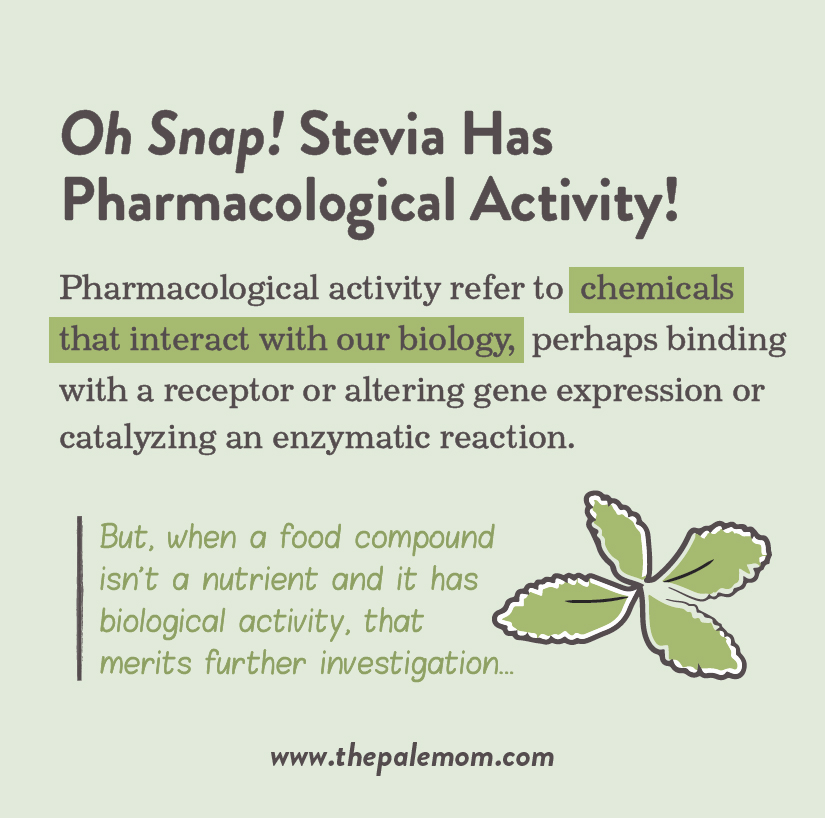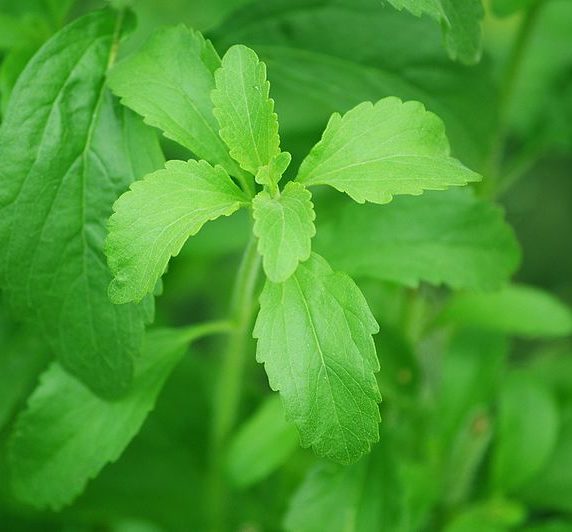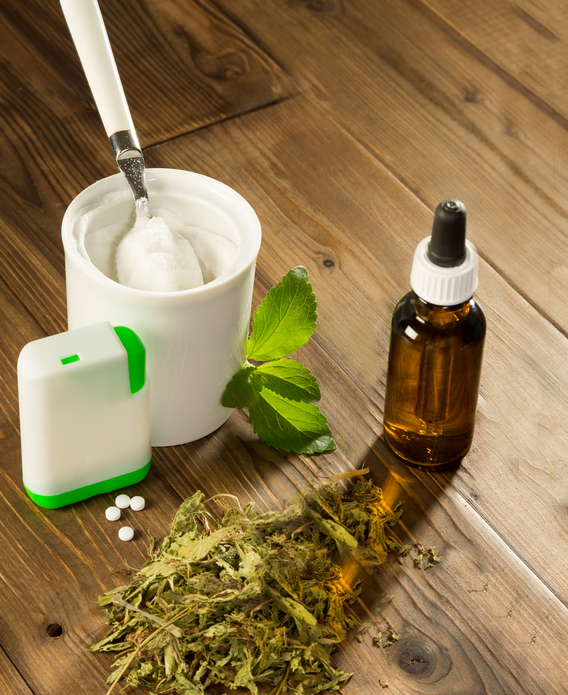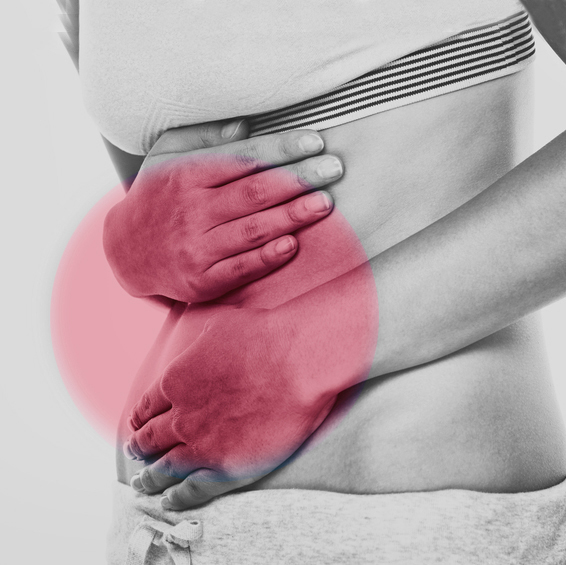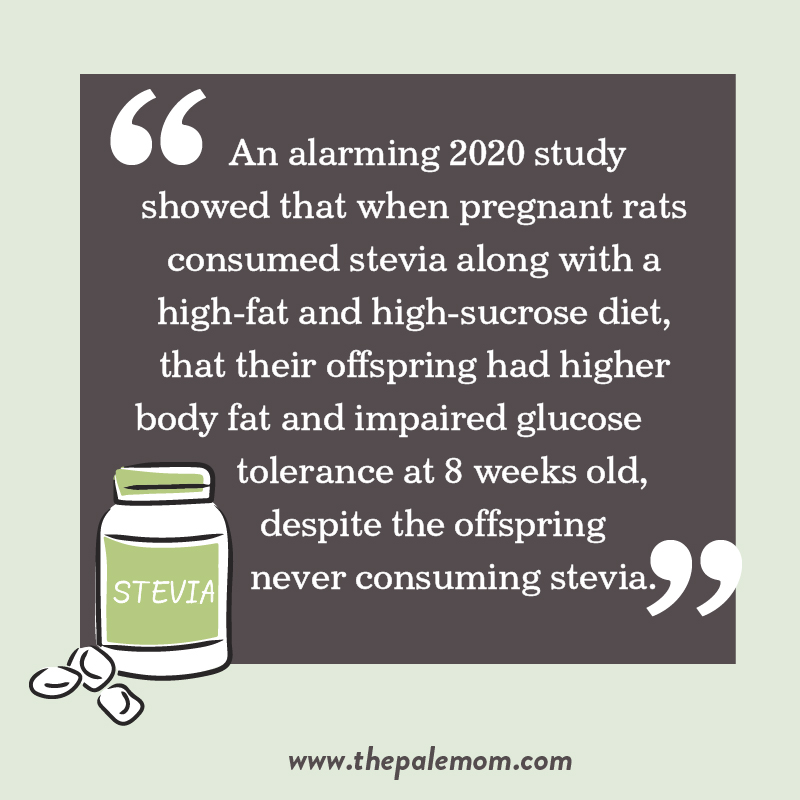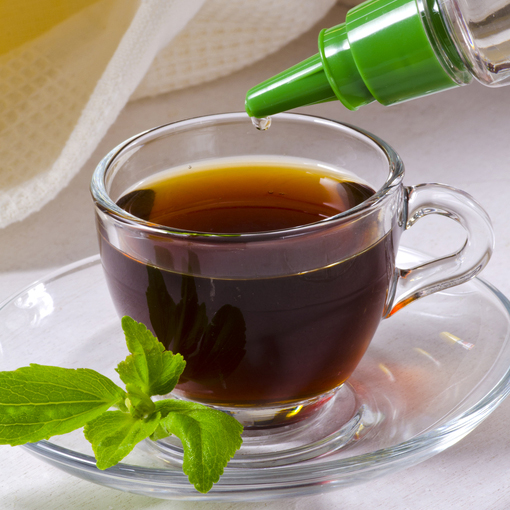While many people in various “real food” communities agree that artificial sweeteners are a bad idea (see Is It Paleo? Splenda, Erythritol, Stevia and other low-calorie sweeteners), stevia is often recommended as a natural sugar substitute because it comes from the leaf of a plant, Stevia rebaudiana Bertoni. It tastes sweet on the tongue, requires very small quantities to sweeten baked goods, and contains no sugar. While some experts advise caution against purified and manufactured forms of stevia, green leaf stevia is typically endorsed. On the surface, it sounds like a perfect solution. Unfortunately, digging a bit deeper reveals some reasons for caution along with the common theme: There’s just no way to cheat sweet.
Why Does Stevia Taste Sweet?
The genus Stevia includes 230 species of annual and perennial herbs and shrubs that grow in a variety of environments and climates. Stevia rebaudiana Bertoni is native to Paraguay but is cultivated all over the world. Its name honors the botanist who first described it (Bertoni) and the chemist who first extracted the chemicals responsible for stevia’s sweet taste, steviol glycosides (Rebaudi). It is the only species of Stevia that tastes sweet.
There are at least ten different steviol glycosides present in the stevia plant. These include stevioside, rebaudioside (A to F), steviolbioside, dihydroisosteviol, rubusoside, and dulcoside A. Purified/manufactured forms of stevia often isolate one or two of these steviol glycosides (most commonly rebaudioside A, but also stevioside), whereas green leaf stevia (which is simply the dried and powdered leaves of the stevia plant) contains all ten. Steviol glycosides are approximately 200 to 400 times sweeter than sucrose by weight, meaning a few nearly calorie-free drops of a concentrated stevia extract can sweeten entire batches of baked goods.
While purified and isolated forms of steviol glycosides are FDA-approved as food additives, whole stevia, stevia leaf and crude stevia are still not GRAS (generally recognized as safe) due to inadequate toxicological information and are only approved as supplements.
Toxicological studies have shown that steviol glycosides are not teratogenic or carcinogenic and cause no acute and subacute toxicity, although there is evidence that stevia is mutagenic at high doses (this is the reason for the ADI, read below for more information). Because these studies tend to use quite high concentrations, they are readily discarded in discussions of the overall safety of consuming stevia. But, whether or not stevia causes genetic mutations is not the only cause for concern, however, even if safety studies focus on this particular property. In fact, stevia requires major caution because there is evidence that it is pharmacologically active after consumption with endocrine disrupting properties (see BPA: Should We Be Worried?) and antimicrobial effects that can negatively impact the gut microbiome (see What Is the Gut Microbiome? And Why Should We Care About It?).
Oh Snap! Stevia Has Pharmacological Activity!
The terms biological activity and pharmacological activity can be used interchangeably. They refer to chemicals (such as drugs) that interact with our biology, perhaps binding with a receptor or altering gene expression or catalyzing an enzymatic reaction. A compound in food having biological activity isn’t automatically a reason for concern. Glucose, the monosaccharide that starch molecules are made up of and one of two saccharides in sucrose (i.e., table sugar) has biological activity after all—its main role is as a source of energy. Other examples of biologically active food compounds include vitamins, minerals, polyphenols, amino acids, and fatty acids—yes, nutrients all have biological activity and in fact, we classify nutrients based on their specific effects. But, when a food compound isn’t a nutrient and it has biological activity, that certainly merits further investigation.
Studies show that steviol glycosides are biologically active. Steviol glycosides are synthesized in the same pathway as, and end up being structurally very similar to, the plant hormones gibberellin and kaurene. This means that steviol glycosides have a steroid hormone structure. Examples of steroid hormones are cortisol, testosterone, progesterone and estrogen. So, it’s not really surprising that steviol glycosides act like a hormone and interact with hormone systems in our body.
For the most part, the pharmacological effects of steviol glycosides could have some potential benefits to human health, including potentially antidiabetic, anticariogenic, antioxidant, hypotensive, antihypertensive, antimicrobial, anti-inflammatory and antitumor activities. (More studies are needed to confirm and quantify all of these effects, especially in humans.)
In fact, the antidiabetic actions of steviol glycosides aren’t simply because stevia is a nonnutritive sugar substitute. Cell culture studies published in both 2015 and 2017 in different cell types showed that steviol and stevioside have functional similarity to insulin, and that they can actually mimic insulin activity, controlling glucose transport into cells. And a 2017 study in mice showed that stevioside could increase the pancreatic insulin release in response to a glucose tolerance test in both wildtype mice and obese mice fed a high-fat diet, reducing hyperglycemia and improving glucose tolerance, but also not causing reactive hypoglycemia even at high doses. The effect was mediated through type II taste receptor cells that detect sweet, bitter and umami—mice who were genetically modified to lack this particular taste receptor (called Trpm5) did not have the same increase in insulin release nor benefit to glucose tolerance from steviol glycosides. This same study also revealed that, while stevioside could prevent hyperglycemia, there was a rebound effect on insulin resistance once it was withdrawn.
Nutrivore Weekly Serving Matrix
An easy-to-use and flexible weekly checklist
to help you maximize nutrient-density.
The Weekly Serving Matrix is very helpful! I’ve been eating along these lines but this really helps me know where to focus vs. which foods serve a more secondary role. It’s super helpful and has taken a lot of worry out of my meal planning. Thanks!
Jan
It’s also worth noting that these antidiabetic effects have not been replicated at low doses of stevia, and a 2019 study showed a far greater benefit to body composition and glucose tolerance in a rat model of diabetes from the addition of supplemental fiber compared to chronic low doses of steviol glycosides, which had negligible effect. And a 2020 study showed that stevia could not restore glucose tolerance in obese mice who continued to eat a high-fat diet. Overall, the studies performed so far imply that stevia is likely something that’s better prescribed and dosed (and combined with a prudent diet for diabetes), rather than used as a food additive. And, if steviol glycosides were turned into a drug to help treat type 2 diabetes, it would almost certainly come with a warning label. Read on for a clue as to what that warning label might say!
Stevia Is an Endocrine Disruptor
The fact that steviol glycosides have a steroid hormone structure might get your spidy sense tingling. Because steviol glycosides have insulin-mimicking properties and can influence insulin secretion from the pancreas, they qualify as endocrine disruptors. But, that’s not all: There’s also growing evidence that steviol glycosides interacts with sex hormones, and this is definitely worth a detailed discussion!
Let’s start with what exactly the endocrine system is. The endocrine system is made up of glands that secrete hormones into the circulatory system in order to reach target organs. Hormones are fat-based molecules produced by the endocrine organs; they act as chemical messengers that make contact with virtually every cell in the body, similar to a long-distance communication system. There are more than fifty different hormones sending out different kinds of signals, and the variety of functions they control is vast. The endocrine glands include the pituitary gland, pineal gland, thyroid gland, hypothalamus, adrenal glands, parathyroid gland, pancreas, and ovaries or testes. Although the signaling role of the endocrine system is similar to that of the nervous system, the endocrine system’s effects are initiated much more slowly and can last weeks (compared to the nervous system’s quick transmission time and short-lived responses).
The endocrine system makes extensive use of negative feedback loops to maintain homeostasis (the maintenance of a stable environment inside and outside the cells). A good analogy here is a thermostat: when the temperature drops too low, the thermostat signals the heater to kick on to bring the temperature back up. When the desired temperature is reached, the thermostat tells the heater to turn off. This cycle repeats to keep the temperature within a comfortable range. Likewise, the endocrine system—particularly the pituitary gland and hypothalamus—is set up to increase hormone production when levels get too low and to inhibit hormone production once levels rise above a certain threshold. For instance, the hypothalamic-pituitary-thyroid axis uses a negative feedback loop to control thyroid hormone: the hypothalamus secretes thyroid-releasing hormone (TRH), in turn stimulating cells in the pituitary gland to secrete thyroid-stimulating hormone (TSH). TSH then binds to receptors in the thyroid and spurs the production of thyroid hormone. When levels of thyroid hormone in the blood rise above a certain threshold, the hypothalamus is inhibited from secreting TRH, and the process is diminished until levels drop.
So, what exactly is an endocrine disruptor? The World Health Organization defines endocrine disrupting chemicals as “an exogenous substance or mixture that alters function(s) of the endocrine system and consequently causes adverse health effects in an intact organism, or its progeny, or (sub)populations”. Basically, it’s any chemical that messes up any hormone, hormone receptor, or negative feedback loop in the endocrine system.
In addition to their interaction with insulin, there is strong evidence that steviol glycosides impact progesterone levels and receptor binding.
The original research pointing to this possibility came from animal studies showing contraceptive effects of stevia in both males and females. In particular, stevioside has been shown to have potent contraceptive properties in female rats, implying that stevia may have an impact on estrogen, progesterone, or both. In another study, male rats fed stevia extracts showed decreased fertility, reduced testosterone levels, and testicular atrophy, potentially attributable to the binding of steviol glycosides with an androgen receptor. Because not all studies using various isolated steviol glycosides replicated these results, they were a matter for debate until a landmark study published in 2016.
The 2016 study confirmed the endocrine disrupting potential of stevioside, rebaudioside A and steviol on progesterone at the level of nuclear receptor transcriptional activity (activating gene transcription to produce proteins) and steroidogenesis (creation of steroid hormones). In particular, stevia increases production of progesterone, while antagonizing (blocking) its receptor (the study specifically looked at the progesterone receptor CatSper in sperm). Progesterone is essential for female reproductive health, including maintaining pregnancy, regulating the menstrual cycle, and fertility. In fact, progesterone receptor antagonists are used clinically as contraceptives and to terminate pregnancy. This information seems to confirm an impact of stevia on fertility, perhaps explaining the efficacy of the traditional use of the stevia plan to control fertility in women of the Guarani Indians in southern Brazil.
There is a complex crosstalk between insulin and sex hormones (see The Case for More Carbs: Insulin’s NonMetabolic Roles in the Human Body), and there’s preliminary evidence for an overall beneficial effect in the context of diabetes. A 2019 study in diabetic male rats showed that stevia extract increased luteinizing hormone, testosterone, and increased expression of the gene encoding steroidogenic acute regulatory protein (Star). In this particular case, stevia extract partially reversed the decreased fertility caused by diabetes, even partially restoring sperm counts, comparable in magnitude of effect to treatment with metformin. As is often the case with compounds that impact sex hormones, whether or not they are beneficial or harmful is context dependent.
There is definitely a need for further studies of the endocrine disrupting potential of steviol glycosides, including whether the effects vary depending on context. For now though, there’s enough evidence to suggest that anyone with hormone imbalances or fertility concerns are best served by avoiding stevia. I can completely imagine a future stevia-based drug for diabetes including a warning to avoid use for women of child-bearing age and during pregnancy and lactation (I’ll expand on that below). See also How Chronic Stress Leads to Hormone Imbalance and The Link between the Thyroid and Infertility.
Stevia Is Bad for the Gut
The antimicrobial properties of stevia are also interesting yet potentially concerning. Stevia is bactericidal (antibiotic) for several food-borne pathogenic bacteria, including enterohemorrhagic Escherichia coli , Salmonella typhimurium, Bacillus subtilis, and Staphylococcus aureus. That might look like good news; but unfortunately, studies show that stevia isn’t a selective antimicrobial (like, for example, tea polyphenols, see The Health Benefits of Tea) and also kills or inhibits several important probiotic species. For example, a 2014 study also showed that stevioside and rebaudioside A dramatically inhibited growth and activity of six Lactobacillus reuteri strains, an extremely important probiotic for human health, and a keystone resident of a healthy and diverse gut microbiome. In fact, a 2003 study showed that, while Bacteroides were able to utilize stevioside and rebaudioside A as substrate, many important probiotic genera—including Lactobacillus, Bifidobacterium, Clostridium, coliform, and Enterococcus species—could not metabolize steviol glycosides. When cultured with human fecal samples, stevioside inhibited the growth of anaerobic bacteria, and rebaudioside A inhibited the growth of aerobic bacteria, especially coliform bacteria. See also What Is the Gut Microbiome? And Why Should We Care About It? and The Gut Health Guidebook.
A 2019 study evaluated the impact of rebaudioside A with or without prebiotic supplementation on gut permeability and the gut microbiome, and showed that stevia could blunt some of the gut health benefits of prebiotics. In particular, the addition of rebaudioside A reduced abundance of Bifidobacteriaceae, Clostridiales family XIII and Ruminococcaceae UCG 005 and increased abundance of Akkermansia muciniphila, Akkermansiaceae, Bacteroides goldsteinii and Bacteroides thetaiotaomicron. The authors conclude that stevia’s “impact on gut microbial taxa should be further examined in populations exhibiting dysbiosis such as obesity.”
A 2020 study showed that stevia could not reverse the detriment to the gut microbiome or glucose metabolism in diet-induced obese mice. In fact, 10-weeks of stevia magnified the increased ratio of Firmicutes to Bacteroidetes caused by high-fat diet, in addition to reducing Tenericutes and increasing Proteobacteria and Actinobacteria, with greater detrimental effects on gut microbiome composition in females compared to males.
And, an alarming 2020 study showed that when pregnant rats consumed stevia along with a high-fat and high-sucrose diet, that their offspring had higher body fat and impaired glucose tolerance at 8 weeks old, despite the offspring never consuming stevia. The detriment was at least in part attributed to altered gut microbiomes, including a reduction in Lactobacillus species and overabundance of Porphyromonadaceae (many species of which are infectious or associated with health problems, including gingivitis, liver cirrhosis, and colorectal carcinoma), in both the pregnant and lactating moms and their pups. When germ-free mice received fecal microbiota transplants from the pups of stevia-consuming obese moms, they gained weight, increased body fat, and became glucose intolerant (even more so than from obese controls who were not fed non-nutritive sweeteners). And, the detriment of stevia to pup metabolism was even greater than aspartame, which was also studied.
All-in-all, these studies show that stevia can suppress the growth of key probiotic strains and magnify the dysbiosis caused by high-fat diets, potentially even driving obesity via gut microbiome composition.
Acceptable Daily Intake of Stevia
Because there is evidence that, at high doses, stevia is mutagenic, the World Health Organization has established 4 milligrams per kilogram (2.2 pounds) of body weight of steviol, in the form of steviol glycosides, as the safe upper limit for daily human consumption, called the Acceptable Daily Intake (ADI). The level is 100 times higher than the no-observed-adverse-effect-level (NOAEL) from a carcinogenicity study of rats fed a diet containing 2.5% stevioside (equivalent to 388 mg steviols /kg BW/day). For a 150-pound person, that equals approximately 40 packets of a stevia sweetener, which on the surface, sounds like we have nothing to worry about.
However, some estimates of steviol glycoside exposure (both in children and adults) suggest that we might exceed the ADI with much lower levels of consumption, meaning that many of us could be consuming enough stevia to cause health problems beyond the endocrine disrupting and gut dysbiosis enhancing effects. How does that work? The ADI is also based on studies that show that we don’t absorb steviol glycosides very well after consuming them, but newer research demonstrates that our gut bacteria can hydrolyse (cut apart) steviol glycosides into steviol, which is much more easily absorbed into the body where the liver then rapidly converts it into its conjugate, steviol glucoronide. Steviol and its conjugate (steviol glucuronide) can be measured in the blood after ingestion of feasible doses of either stevioside or rebaudioside. With this information, in addition to the now known endocrine disrupting and gut microbiome effects of stevia, the ADI clearly needs to be re-evaluated.
Take-Home Message
Occasional consumption of small amounts of stevia likely has little to no impact on general health. Unfortunately, there really is a shortage of human studies evaluating the full spectrum of possible negative effects of stevia and no human studies exploring the potential effects on fertility or gut dybiosis! In the case of stevia, caution is the better part of valor, especially for anyone struggling with fertility issues, hormone imbalances, or chronic disease.
Once again, there just seems to be no way to cheat sweet. While excessive consumption of sugars are harmful to insulin sensitivity and glucose metabolism (see The Case for More Carbs: Insulin’s NonMetabolic Roles in the Human Body, How Many Carbs Should We Eat?, 3 Ways to Regulate Insulin that Have Nothing to Do With Food), there doesn’t seem to be a sweet substitute that isn’t going from the frying pan to the fire (see also Is It Paleo? Fructose and Fructose-Based Sweeteners (I’m looking at you, Agave!), Is It Paleo? Splenda, Erythritol, Stevia and other low-calorie sweeteners, and What’s the Next Superfood Sweetener?, which addresses monk fruit).
Instead, I recommend occasional and moderate consumption of natural sugars like molasses, honey, maple syrup and organic cane sugar, see How Does Sugar Fit into a Healthy Diet?. And, of course, fresh fruit is a great choice for daily consumption! See Why Fruit is a Good Source of Carbohydrates, The Health Benefits of Berries, The Health Benefits of Citrus Fruits, The Health Benefits of Apples, The Health Benefits of Bananas and Plantains, The Health Benefits of Melons, and The Health Benefits of Tropical Fruits.
Citations
Becker SL, Chiang E, Plantinga A, Carey HV, Suen G, Swoap SJ. Effect of stevia on the gut microbiota and glucose tolerance in a murine model of diet-induced obesity. FEMS Microbiol Ecol. 2020 Jun 1;96(6):fiaa079. doi: 10.1093/femsec/fiaa079.
Bhasker S, Madhav H, Chinnamma M. Molecular evidence of insulinomimetic property exhibited by steviol and stevioside in diabetes induced L6 and 3T3L1 cells. Phytomedicine. 2015 Oct 15;22(11):1037-44. doi: 10.1016/j.phymed.2015.07.007.
Brusick DJ. A critical review of the genetic toxicity of steviol and steviol glycosides. Food Chem Toxicol. 2008 Jul;46 Suppl 7:S83-91. doi: 10.1016/j.fct.2008.05.002.
Deniņa I, Semjonovs P, Fomina A, Treimane R, Linde R. The influence of stevia glycosides on the growth of Lactobacillus reuteri strains. Lett Appl Microbiol. 2014 Mar;58(3):278-84. doi: 10.1111/lam.12187. Epub 2013 Nov 19. PMID: 24251876.
Gardana C, Simonetti P, Canzi E, Zanchi R, Pietta P. Metabolism of stevioside and rebaudioside A from Stevia rebaudiana extracts by human microflora. J Agric Food Chem. 2003 Oct 22;51(22):6618-22. doi: 10.1021/jf0303619.
Gerasimidis K, Bryden K, Chen X, Papachristou E, Verney A, Roig M, Hansen R, Nichols B, Papadopoulou R, Parrett A. The impact of food additives, artificial sweeteners and domestic hygiene products on the human gut microbiome and its fibre fermentation capacity. Eur J Nutr. 2020 Oct;59(7):3213-3230. doi: 10.1007/s00394-019-02161-8.
Gholizadeh F, Dastghaib S, Koohpeyma F, Bayat E, Mokarram P. The protective effect of Stevia rebaudiana Bertoni on serum hormone levels, key steroidogenesis enzymes, and testicular damage in testes of diabetic rats. Acta Histochem. 2019 Oct;121(7):833-840. doi: 10.1016/j.acthis.2019.08.001.
Mahalak KK, Firrman J, Tomasula PM, Nuñez A, Lee JJ, Bittinger K, Rinaldi W, Liu LS. Impact of Steviol Glycosides and Erythritol on the Human and Cebus apella Gut Microbiome. J Agric Food Chem. 2020 Nov 18;68(46):13093-13101. doi: 10.1021/acs.jafc.9b06181.
Melis MS. Chronic administration of aqueous extract of Stevia rebaudiana in rats: renal effects. J Ethnopharmacol. 1995 Jul 28;47(3):129-34. doi: 10.1016/0378-8741(95)01271-e.
Melis MS. Effects of chronic administration of Stevia rebaudiana on fertility in rats. J Ethnopharmacol. 1999 Nov 1;67(2):157-61. doi: 10.1016/s0378-8741(99)00081-1.
Momtazi-Borojeni AA, Esmaeili SA, Abdollahi E, Sahebkar A. A Review on the Pharmacology and Toxicology of Steviol Glycosides Extracted from Stevia rebaudiana. Curr Pharm Des. 2017;23(11):1616-1622. doi: 10.2174/1381612822666161021142835.
Nettleton JE, Cho NA, Klancic T, Nicolucci AC, Shearer J, Borgland SL, Johnston LA, Ramay HR, Noye Tuplin E, Chleilat F, Thomson C, Mayengbam S, McCoy KD, Reimer RA. Maternal low-dose aspartame and stevia consumption with an obesogenic diet alters metabolism, gut microbiota and mesolimbic reward system in rat dams and their offspring. Gut. 2020 Oct;69(10):1807-1817. doi: 10.1136/gutjnl-2018-317505.
Nettleton JE, Klancic T, Schick A, Choo AC, Shearer J, Borgland SL, Chleilat F, Mayengbam S, Reimer RA. Low-Dose Stevia (Rebaudioside A) Consumption Perturbs Gut Microbiota and the Mesolimbic Dopamine Reward System. Nutrients. 2019 May 31;11(6):1248. doi: 10.3390/nu11061248.
Oliveira-Filho RM, Uehara OA, Minetti CA, Valle LB. Chronic administration of aqueous extract of Stevia rebaudiana (Bert.) Bertoni in rats: endocrine effects. Gen Pharmacol. 1989;20(2):187-91. doi: 10.1016/0306-3623(89)90013-x.
Pawar RS, Krynitsky AJ, Rader JI. Sweeteners from plants–with emphasis on Stevia rebaudiana (Bertoni) and Siraitia grosvenorii (Swingle). Anal Bioanal Chem. 2013 May;405(13):4397-407. doi: 10.1007/s00216-012-6693-0.
Planas GM, Kucacute J. Contraceptive Properties of Stevia rebaudiana. Science. 1968 Nov 29;162(3857):1007. doi: 10.1126/science.162.3857.1007.
Prata C, Zambonin L, Rizzo B, Maraldi T, Angeloni C, Vieceli Dalla Sega F, Fiorentini D, Hrelia S. Glycosides from Stevia rebaudiana Bertoni Possess Insulin-Mimetic and Antioxidant Activities in Rat Cardiac Fibroblasts. Oxid Med Cell Longev. 2017;2017:3724545. doi: 10.1155/2017/3724545.
Rojas E, Bermúdez V, Motlaghzadeh Y, Mathew J, Fidilio E, Faria J, Rojas J, de Bravo MC, Contreras J, Mantilla LP, Angarita L, Sepúlveda PA, Kuzmar I. Stevia rebaudiana Bertoni and Its Effects in Human Disease: Emphasizing Its Role in Inflammation, Atherosclerosis and Metabolic Syndrome. Curr Nutr Rep. 2018 Jul 11. doi: 10.1007/s13668-018-0228-z.
Ruiz-Ojeda FJ, Plaza-Díaz J, Sáez-Lara MJ, Gil A. Effects of Sweeteners on the Gut Microbiota: A Review of Experimental Studies and Clinical Trials. Adv Nutr. 2019 Jan 1;10(suppl_1):S31-S48. doi: 10.1093/advances/nmy037.
Ruiz-Ruiz JC, Moguel-Ordoñez YB, Segura-Campos MR. Biological activity of Stevia rebaudiana Bertoni and their relationship to health. Crit Rev Food Sci Nutr. 2017 Aug 13;57(12):2680-2690. doi: 10.1080/10408398.2015.1072083.
Shannon M, Rehfeld A, Frizzell C, Livingstone C, McGonagle C, Skakkebaek NE, Wielogórska E, Connolly L. In vitro bioassay investigations of the endocrine disrupting potential of steviol glycosides and their metabolite steviol, components of the natural sweetener Stevia. Mol Cell Endocrinol. 2016 May 15;427:65-72. doi: 10.1016/j.mce.2016.03.005.
Wang QP, Browman D, Herzog H, Neely GG. Non-nutritive sweeteners possess a bacteriostatic effect and alter gut microbiota in mice. PLoS One. 2018 Jul 5;13(7):e0199080. doi: 10.1371/journal.pone.0199080.
Wheeler A, Boileau AC, Winkler PC, Compton JC, Prakash I, Jiang X, Mandarino DA. Pharmacokinetics of rebaudioside A and stevioside after single oral doses in healthy men. Food Chem Toxicol. 2008 Jul;46 Suppl 7:S54-60. doi: 10.1016/j.fct.2008.04.041.
Xili L, Chengjiany B, Eryi X, Reiming S, Yuengming W, Haodong S, Zhiyian H. Chronic oral toxicity and carcinogenicity study of stevioside in rats. Food Chem Toxicol. 1992 Nov;30(11):957-65. doi: 10.1016/0278-6915(92)90181-j.



